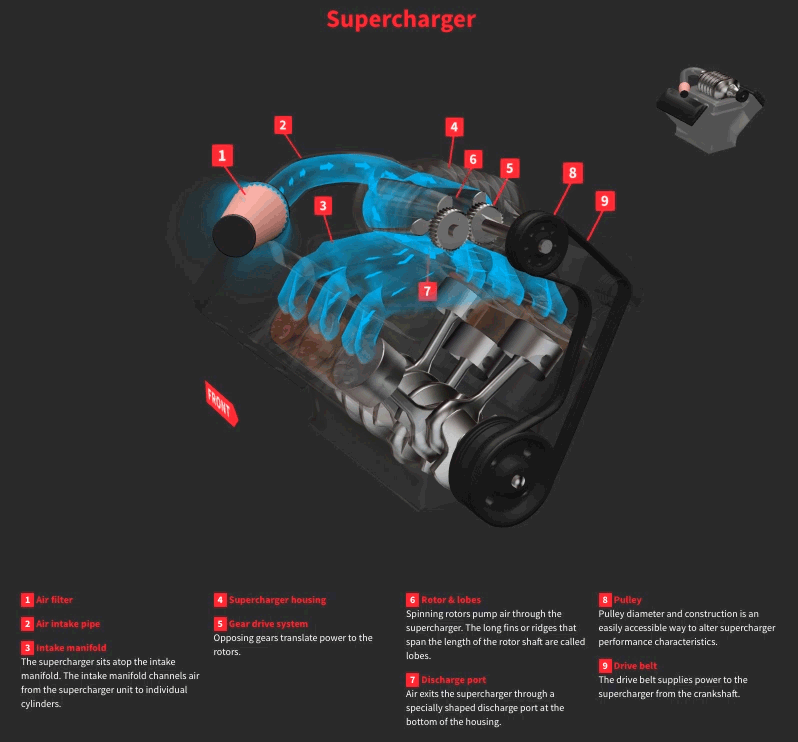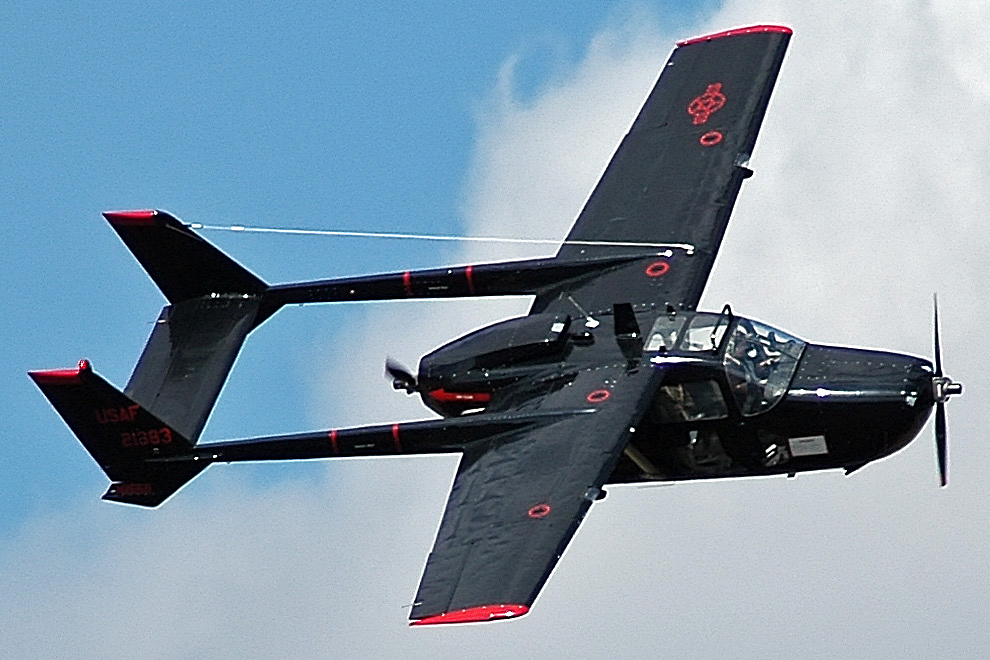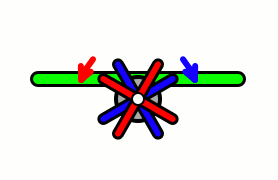|
DFW R.III
The DFW R.III was a heavy bomber () biplane aircraft to be built by the (DFW) during the First World War for the Imperial German Army's () Imperial German Air Service (). Design work had begun two months before the end of the war in November 1918, but was terminated at that time before construction began. Development The Inspectorate of Flying Troops ( ordered two improved versions of the company's preceding R.II bomber on 3 September 1918. That aircraft's flying performance was mediocre and more power was thought to be the answer. More powerful engines were not available so the number of engines was doubled to eight Mercedes D.IVas in the fuselage. Each was to be connected to a coaxial contra-rotating propeller in a push-pull configuration via a driveshaft. The propeller gearboxes were to be housed in a nacelle between the wings that also contained the fuel tanks. Another concept examined was use pairs of engines geared together to a single propeller, also in a push-pull arr ... [...More Info...] [...Related Items...] OR: [Wikipedia] [Google] [Baidu] |
WikiProject Aircraft
A WikiProject, or Wikiproject, is an affinity group for contributors with shared goals within the Wikimedia movement. WikiProjects are prevalent within the largest wiki, Wikipedia, and exist to varying degrees within Wikimedia project, sibling projects such as Wiktionary, Wikiquote, Wikidata, and Wikisource. They also exist in different languages, and translation of articles is a form of their collaboration. During the COVID-19 pandemic, CBS News noted the role of Wikipedia's WikiProject Medicine in maintaining the accuracy of articles related to the disease. Another WikiProject that has drawn attention is WikiProject Women Scientists, which was profiled by ''Smithsonian Magazine, Smithsonian'' for its efforts to improve coverage of women scientists which the profile noted had "helped increase the number of female scientists on Wikipedia from around 1,600 to over 5,000". On Wikipedia Some Wikipedia WikiProjects are substantial enough to engage in cooperative activities with outsi ... [...More Info...] [...Related Items...] OR: [Wikipedia] [Google] [Baidu] |
Coaxial
In geometry, coaxial means that several three-dimensional linear or planar forms share a common axis. The two-dimensional analog is ''concentric''. Common examples: A coaxial cable has a wire conductor in the centre (D), a circumferential outer conductor (B), and an insulating medium called the dielectric (C) separating these two conductors. The outer conductor is usually sheathed in a protective PVC outer jacket (A). All these have a common axis. The dimension and material of the conductors and insulation determine the cable's characteristic impedance and attenuation at various frequencies. Coaxial rotors are a three-dimensional planar structure: a pair of helicopter rotors (wings) mounted one above the other on concentric shafts, with the same axis of rotation (but turning in opposite directions). In loudspeaker design, coaxial speakers are a loudspeaker system in which the individual drivers are mounted close to one another on the same axis, and thus radiate sound along t ... [...More Info...] [...Related Items...] OR: [Wikipedia] [Google] [Baidu] |
Straight-six Engine
A straight-six engine (also referred to as an inline-six engine; abbreviated I6 or L6) is a piston engine with six cylinders arranged in a straight line along the crankshaft. A straight-six engine has perfect primary and secondary engine balance, resulting in fewer vibrations than other designs of six or fewer cylinders. Until the mid-20th century, the straight-six layout was the most common design for engines with six cylinders. However, V6 engines gradually became more common in the 1970s and by the 2000s, V6 engines had replaced straight-six engines in most light automotive applications. Characteristics In terms of packaging, straight-six engines are almost always narrower than a V6 engine or V8 engine, but longer than straight-four engines, V6s, and most V8s. Compared to V-configuration engines with similar power and displacement, the straight configuration has fewer injectors, a single head, and a single exhaust manifold, all contributing to better reliability and perfor ... [...More Info...] [...Related Items...] OR: [Wikipedia] [Google] [Baidu] |
Air Gunner
An air gunner or aerial gunner is a member of a military aircrew who operates flexible-mount or turret-mounted machine guns or autocannons in an aircraft. Modern aircraft weapons are usually operated automatically without the need for a dedicated air gunner, but older generation (World War II and earlier) bombers used to carry up to eight air gunners. Most modern air gunners are helicopter door gunners, who typically have other primary roles such as crew chief or observer in addition to their air gunner role. Others fly as members of aircrews on gunships, where their duties may include loading guns or manually firing them if computer systems fail. A modern gunner can be someone who operates armament on an aircraft besides the pilot An aircraft pilot or aviator is a person who controls the flight of an aircraft by operating its Aircraft flight control system, directional flight controls. Some other aircrew, aircrew members, such as navigators or flight engineers, are ... [...More Info...] [...Related Items...] OR: [Wikipedia] [Google] [Baidu] |
Navigator
A navigator is the person on board a ship or aircraft responsible for its navigation.Grierson, MikeAviation History—Demise of the Flight Navigator FrancoFlyers.org website, October 14, 2008. Retrieved August 31, 2014. The navigator's primary responsibility is to be aware of ship or aircraft position at all times. Responsibilities include planning the journey, advising the Captain (nautical), ship's captain or aircraft commander of estimated timing to destinations while en route, and ensuring hazards are avoided. The navigator is in charge of maintaining the aircraft or ship's nautical charts, nautical publications, and navigational equipment, and they generally have responsibility for meteorological equipment and communications. With the advent of satellite navigation, the effort required to accurately determine one's position has decreased by orders of magnitude, so the entire field has experienced a revolutionary transition since the 1990s with traditional navigation ta ... [...More Info...] [...Related Items...] OR: [Wikipedia] [Google] [Baidu] |
Supercharger
In an internal combustion engine, a supercharger compresses the intake gas, forcing more air into the engine in order to produce more power for a given displacement (engine), displacement. It is a form of forced induction that is mechanically powered (usually by a belt from the engine's crankshaft), as opposed to a turbocharger, which is powered by the kinetic energy of the exhaust gases. However, up until the mid-20th century, a turbocharger was called a "turbosupercharger" and was considered a type of supercharger. The first supercharged engine was built in 1878, with usage in aircraft engines beginning in the 1910s and usage in car engines beginning in the 1920s. In piston engines used by aircraft, supercharging was often used to compensate for the lower air density at high altitudes. Supercharging is less commonly used in the 21st century, as manufacturers have shifted to turbochargers to reduce fuel consumption and increase power outputs, especially with reduced engine dis ... [...More Info...] [...Related Items...] OR: [Wikipedia] [Google] [Baidu] |
Nacelle
A nacelle ( ) is a streamlined container for aircraft parts such as Aircraft engine, engines, fuel or equipment. When attached entirely outside the airframe, it is sometimes called a pod, in which case it is attached with a Hardpoint#Pylon, pylon or strut and the engine is known as a podded engine. In some cases—for instance in the typical "Farman Aviation Works, Farman" type Pusher configuration, "pusher" aircraft, or the World War II-era P-38 Lightning or SAAB J21—an aircraft cockpit may also be housed in a nacelle, rather than in a conventional fuselage. Etymology Like many aviation terms, the word comes from French language, French, in this case from a word for a small boat. Development file:Arado Ar 234V6 and Ar 234V8 front-view silhouettes.png, The development of the Arado Ar 234, merging the four nacelles into two The Arado Ar 234 was one of the first operational jet aircraft with engines mounted in nacelles. During its development, the four engines had four distin ... [...More Info...] [...Related Items...] OR: [Wikipedia] [Google] [Baidu] |
Gearbox
A transmission (also called a gearbox) is a mechanical device invented by Louis Renault (who founded Renault) which uses a gear set—two or more gears working together—to change the speed, direction of rotation, or torque multiplication/reduction in a machine. Transmissions can have a single fixed-gear ratio, multiple distinct gear ratios, or continuously variable ratios. Variable-ratio transmissions are used in all sorts of machinery, especially vehicles. Applications Early uses Early transmissions included the right-angle drives and other gearing in windmills, horse-powered devices, and steam-powered devices. Applications of these devices included pumps, mills and hoists. Bicycles Bicycles traditionally have used hub gear or Derailleur gear transmissions, but there are other more recent design innovations. Automobiles Since the torque and power output of an internal combustion engine (ICE) varies with its rpm, automobiles powered by ICEs require multiple ... [...More Info...] [...Related Items...] OR: [Wikipedia] [Google] [Baidu] |
Driveshaft
A drive shaft, driveshaft, driving shaft, tailshaft (Australian English), propeller shaft (prop shaft), or Cardan shaft (after Girolamo Cardano) is a component for transmitting mechanical power, torque, and rotation, usually used to connect other components of a drivetrain that cannot be connected directly because of distance or the need to allow for relative movement between them. As torque carriers, drive shafts are subject to torsion and shear stress, equivalent to the difference between the input torque and the load. They must therefore be strong enough to bear the stress, while avoiding too much additional weight as that would in turn increase their inertia. To allow for variations in the alignment and distance between the driving and driven components, drive shafts frequently incorporate one or more universal joints, jaw couplings, or rag joints, and sometimes a splined joint or prismatic joint. History The term ''driveshaft'' first appeared during the mid-19th ... [...More Info...] [...Related Items...] OR: [Wikipedia] [Google] [Baidu] |
Push-pull Configuration
An aircraft constructed with a push-pull configuration has a combination of forward-mounted Tractor configuration, tractor (pull) Propeller (aircraft), propellers, and backward-mounted (pusher configuration, pusher) propellers. Historical The earliest known examples of "push-pull" engined-layout aircraft was the Short S.27#Short Tandem Twin, Short Tandem Twin. An early pre-World War I example of a "push-pull" aircraft was the Caproni Ca.1 (1914), Caproni Ca.1 of 1914 which had two wing-mounted tractor propellers and one centre-mounted pusher propeller. Around 450 of these and their successor, the Caproni Ca.3, Ca.3 were built. One of the first to employ two engines on a common axis (tandem push-pull) was the one-off, ill-fated Siemens-Schuckert DDr.I fighter aircraft, fighter of 1917. German World War I designs included the only Fokker twin-engined design of the period, the Fokker K.I from 1915; followed by the unusual Siemens-Schuckert DDr.I triplane fighter design of late 191 ... [...More Info...] [...Related Items...] OR: [Wikipedia] [Google] [Baidu] |
Contra-rotating Propeller
Aircraft equipped with contra-rotating propellers (CRP) coaxial contra-rotating propellers, or high-speed propellers, apply the maximum power of usually a single engine piston powered or turboprop engine to drive a pair of coaxial propellers in contra-rotation. Two propellers are arranged one behind the other, and power is transferred from the engine via a planetary gear or spur gear transmission. Although contra-rotating propellers are also known as '' counter-rotating propellers'', the term is much more widely used when referring to airscrews on separate non-coaxial shafts turning in opposite directions. Operation When airspeed is low, the mass of the air flowing through the propeller disk (thrust) causes a significant amount of tangential or rotational air flow to be created by the spinning blades. The energy of this tangential air flow is wasted in a single-propeller design, and causes handling problems at low speed as the air strikes the vertical stabilizer, causing the ... [...More Info...] [...Related Items...] OR: [Wikipedia] [Google] [Baidu] |
Fuselage
The fuselage (; from the French language, French ''fuselé'' "spindle-shaped") is an aircraft's main body section. It holds Aircrew, crew, passengers, or cargo. In single-engine aircraft, it will usually contain an Aircraft engine, engine as well, although in some amphibious aircraft the single engine is mounted on a hardpoint, pylon attached to the fuselage, which in turn is used as a floating Hull (watercraft), hull. The fuselage also serves to position the Flight control surfaces, control and Stabilizer (aeronautics), stabilization surfaces in specific relationships to Wing, lifting surfaces, which is required for aircraft stability and maneuverability. Types of structures Truss structure This type of structure is still in use in many lightweight aircraft using welding, welded steel tube trusses. A box truss fuselage structure can also be built out of wood—often covered with plywood. Simple box structures may be rounded by the addition of supported lightweight strin ... [...More Info...] [...Related Items...] OR: [Wikipedia] [Google] [Baidu] |







